how to: take a better photo, an easy guide for beginners
Someone left a comment one of my last posts about wishing they could take better pictures, and so I decided to write down a few of the things I've done to improve. First off, though, if you want some encouragement and to see some seriously lame pictures, check out my old flickr. Um, wow. You can see the beginnings of some good ideas, and you can see the attempts, but for the most part? It's crap. (Oh, and for the record--all those pictures from my wedding were not taken by me. Obviously. They were taken by an awesome friend of mine.) And these aren't super in-depth ideas; they should just get you started. Another disclaimer: I'm going to illustrate points with random photos found on my computer. The fact that they're on there means they were either taken by me or with my camera, and trust me: there's a reason they've not been shown to the world before now. So enjoy laughing at my learning curve.
* move in closer *
So I may overkill on this one, but the single most common mistake I see in photos is shooting too wide. Only include what you need to communicate your message.
Here's an excellent example. The setting is lovely, but by trying to include both the trees and the person, I lose the impact of both. Your eye doesn't really know where to go.
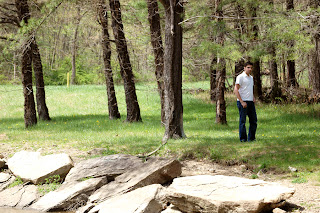
When I zoom in, suddenly you understand the point of the picture. (Isn't his hair... conservative??? Hehehe.)
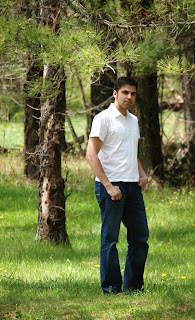
So edit within your camera. Take several photos where you can see the point, rather than trying to fit everything into one shot.
Project: take 5 photos of the same subject, moving in closer each time. Choose the one that best captures the subject. (It might not be the closest one, but it is a possibility.)
*change your angle*
By changing where you take the shot from, you can completely change the feeling of the shot or reveal something new about the subject.
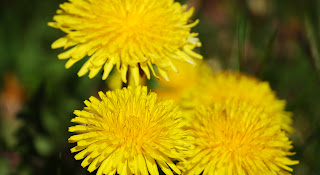
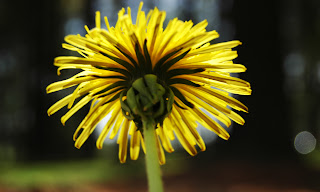
The top picture is a boring, standard "oh! pretty flowers!" shot. The bottom one shows something about a dandelion that you can't see without some effort. Isn't that the whole point of photography? To show something that isn't necessarily obvious?
Here's another example.
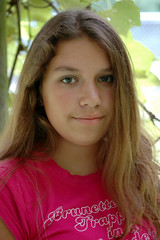

It is our natural tendency to take photos from our eye level--it's easiest that way! But that's also the way everyone else sees. By kneeling down or by standing on a chair, we change the way we see, and that means we're seeing new things.
One more:

It's pretty subtle, but if you look at the left-hand side of this image, you can tell I was kneeling when I took it, which is what it took too emphasize all the lines in the aisle. Shooting from eye-level just didn't have the same impact.
Project: get as high and as low as you can to take pictures of the same subject. How many angles can you find from which to photograph the same thing?
*learn the rule of thirds*
It's quite simple, really. By curing the dreaded "middleitis," images become exponentially more interesting.
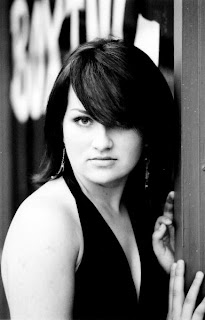
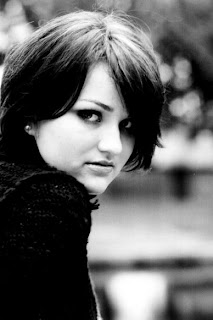
I can also mention here that generally photos are more flattering when they're taken at an angle instead of straight on.
Project: shoot the same subject 4 times, each time using a different "third line" for emphasis.
*learn from others
I love books of photography, and regularly check them our from the library. I also flip through books of the greats, collect magazines with inspiring images, and subscribe to amazing photographers blogs. Whenever I'm stuck, Flickr will definitely give me a kick in the pants. Please note: I'm not saying to copy other photographer's images. I am saying to learn from their creativity. Seeing how they approach a problem will often spark new ideas in you and you'll try things that you never would have thought of left to your own devices.
Project: find 3 new photography blogs that you love and add them to your feedreader.
And finally, the most important thing is
* practice*
I took somewhere upwards of 8,000 images last year. (It was probably over ten thousand, but I'm not positive of that.) I spent hours and hours going through those images, whittling them down, cutting away the so-so ones, editing the ones that remained, and then picking up the camera and doing it all again. I've been taking pictures (with a serious camera) since I was 12, but it really wasn't until last year that I started to work at photography, really work at it, asking for feedback, challenging myself, developing my own little improvement projects. And the results have been pretty impressive: I've improved more in the last year than I had in the previous 13. (At least I think so.) Using a digital camera definitely makes it easier, but it's not the key: the key is worked.
Photographers are fairly divided on the whole art vs. skill debate. Some say that creativity is the key, others glory in technical prowess. I say, with Edison, that "genius is 1% inspiration, 99% perspiration." Creativity is work. It takes effort to continually push yourself to think outside the box. It takes effort to try to see things in new ways. It takes effort to see a beautiful image and not just say "oooo, pretty" but push yourself to learn something from that beauty. Sometimes it is incredibly exhausting to maintain enthusiasm and curiosity about the world around me. However, I am firmly convinced that anyone can learn to take beautiful photographs if they are willing to invest the work required.
So anyway, that's my nifty-cool little suggestions for anyone who wants to take better pictures. Questions? Comments? Please share, either through comments or email (vdoprincess AT gmail DOT com). Photographers, please chime in. What am I forgetting? Am I completely off base here?
And enjoy taking beautiful pictures.
* move in closer *
So I may overkill on this one, but the single most common mistake I see in photos is shooting too wide. Only include what you need to communicate your message.
Here's an excellent example. The setting is lovely, but by trying to include both the trees and the person, I lose the impact of both. Your eye doesn't really know where to go.

When I zoom in, suddenly you understand the point of the picture. (Isn't his hair... conservative??? Hehehe.)

So edit within your camera. Take several photos where you can see the point, rather than trying to fit everything into one shot.
Project: take 5 photos of the same subject, moving in closer each time. Choose the one that best captures the subject. (It might not be the closest one, but it is a possibility.)
*change your angle*
By changing where you take the shot from, you can completely change the feeling of the shot or reveal something new about the subject.


The top picture is a boring, standard "oh! pretty flowers!" shot. The bottom one shows something about a dandelion that you can't see without some effort. Isn't that the whole point of photography? To show something that isn't necessarily obvious?
Here's another example.


It is our natural tendency to take photos from our eye level--it's easiest that way! But that's also the way everyone else sees. By kneeling down or by standing on a chair, we change the way we see, and that means we're seeing new things.
One more:

It's pretty subtle, but if you look at the left-hand side of this image, you can tell I was kneeling when I took it, which is what it took too emphasize all the lines in the aisle. Shooting from eye-level just didn't have the same impact.
Project: get as high and as low as you can to take pictures of the same subject. How many angles can you find from which to photograph the same thing?
*learn the rule of thirds*
It's quite simple, really. By curing the dreaded "middleitis," images become exponentially more interesting.


I can also mention here that generally photos are more flattering when they're taken at an angle instead of straight on.
Project: shoot the same subject 4 times, each time using a different "third line" for emphasis.
*learn from others
I love books of photography, and regularly check them our from the library. I also flip through books of the greats, collect magazines with inspiring images, and subscribe to amazing photographers blogs. Whenever I'm stuck, Flickr will definitely give me a kick in the pants. Please note: I'm not saying to copy other photographer's images. I am saying to learn from their creativity. Seeing how they approach a problem will often spark new ideas in you and you'll try things that you never would have thought of left to your own devices.
Project: find 3 new photography blogs that you love and add them to your feedreader.
And finally, the most important thing is
* practice*
I took somewhere upwards of 8,000 images last year. (It was probably over ten thousand, but I'm not positive of that.) I spent hours and hours going through those images, whittling them down, cutting away the so-so ones, editing the ones that remained, and then picking up the camera and doing it all again. I've been taking pictures (with a serious camera) since I was 12, but it really wasn't until last year that I started to work at photography, really work at it, asking for feedback, challenging myself, developing my own little improvement projects. And the results have been pretty impressive: I've improved more in the last year than I had in the previous 13. (At least I think so.) Using a digital camera definitely makes it easier, but it's not the key: the key is worked.
Photographers are fairly divided on the whole art vs. skill debate. Some say that creativity is the key, others glory in technical prowess. I say, with Edison, that "genius is 1% inspiration, 99% perspiration." Creativity is work. It takes effort to continually push yourself to think outside the box. It takes effort to try to see things in new ways. It takes effort to see a beautiful image and not just say "oooo, pretty" but push yourself to learn something from that beauty. Sometimes it is incredibly exhausting to maintain enthusiasm and curiosity about the world around me. However, I am firmly convinced that anyone can learn to take beautiful photographs if they are willing to invest the work required.
So anyway, that's my nifty-cool little suggestions for anyone who wants to take better pictures. Questions? Comments? Please share, either through comments or email (vdoprincess AT gmail DOT com). Photographers, please chime in. What am I forgetting? Am I completely off base here?
And enjoy taking beautiful pictures.

Comments